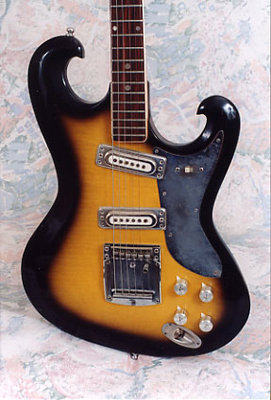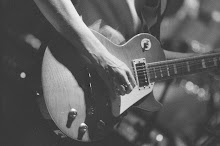

A Guitar Guru examines the meaning of life through guitars, music and the rock&roll lifestyle. Gonzo - a style of journalism which is written subjectively, often including the reporter as part of the story via a first person narrative


 In some ways I can't think of an odder combination than NHL hockey and the Fender Telecaster.
In some ways I can't think of an odder combination than NHL hockey and the Fender Telecaster. 
 ude" was a failure of a marketing name for more than one reason - The first of which was the fact it wasn't so little. I recall mine weighing a small ton. Of course it didn't help that one of the handles had come off and the thing was covered in slippery black leather and was extremely awkward to carry. Of course I shouldn't be too unkind. It was made in the era of poor PA systems so a guy needed a huge amp just to be heard in any sort of decent sized club.
ude" was a failure of a marketing name for more than one reason - The first of which was the fact it wasn't so little. I recall mine weighing a small ton. Of course it didn't help that one of the handles had come off and the thing was covered in slippery black leather and was extremely awkward to carry. Of course I shouldn't be too unkind. It was made in the era of poor PA systems so a guy needed a huge amp just to be heard in any sort of decent sized club.
 An enigmatic man needs and enigmatic guitar. No one knew this more than ex-Rolling Stone Brian Jones.
An enigmatic man needs and enigmatic guitar. No one knew this more than ex-Rolling Stone Brian Jones.  Here's the one I bought. Very similar to Brian's original. The knobs were slightly different (white plastic instead of metal) but otherwise an incredibly faithful visual reproduction. The finish was top-notch. These guitars play like a dream. The round shape feels comfortable against the body, the neck feels great and they are beautifully balanced. Holding one of these will also guarantee you'll stand out on any stage or bandstand.
Here's the one I bought. Very similar to Brian's original. The knobs were slightly different (white plastic instead of metal) but otherwise an incredibly faithful visual reproduction. The finish was top-notch. These guitars play like a dream. The round shape feels comfortable against the body, the neck feels great and they are beautifully balanced. Holding one of these will also guarantee you'll stand out on any stage or bandstand.


 Okay, to the 80s now. Lest anyone think I'm picking on the fairer sex - let's have a look at how the guys stack up hair-wise. Here's Mylon LeFevre (Mylon???). During the 70s Mylon actually played with the likes of Duane Allman, Eric Clapton and George Harrison. He even won a Grammy. Then, after a near fatal drug overdose in 1980, he devoted his life to Jesus and cleaned up his act.
Okay, to the 80s now. Lest anyone think I'm picking on the fairer sex - let's have a look at how the guys stack up hair-wise. Here's Mylon LeFevre (Mylon???). During the 70s Mylon actually played with the likes of Duane Allman, Eric Clapton and George Harrison. He even won a Grammy. Then, after a near fatal drug overdose in 1980, he devoted his life to Jesus and cleaned up his act. If you don't recognize her hair then surely you recognize her face. Yes its Lisa Whelchel who played Blair from the Facts of Life TV show. Lisa's talents also ventured to singing and in the 1980s I remember her being booked to perform at a church not too far from where I lived in Brampton, Ontario. I had a crush on her and even though I wasn't a Baptist, I almost went to see her sing. Almost. Hey, I was probably about 13 and all my friends were into heavy metal. Who was I going to go with? Anyways, back to the hair. It's big, it's Christian, but from a guy who grew up in the 80s, it also rocks. If you're going to have big hair and your a woman, this is how you want to look.
If you don't recognize her hair then surely you recognize her face. Yes its Lisa Whelchel who played Blair from the Facts of Life TV show. Lisa's talents also ventured to singing and in the 1980s I remember her being booked to perform at a church not too far from where I lived in Brampton, Ontario. I had a crush on her and even though I wasn't a Baptist, I almost went to see her sing. Almost. Hey, I was probably about 13 and all my friends were into heavy metal. Who was I going to go with? Anyways, back to the hair. It's big, it's Christian, but from a guy who grew up in the 80s, it also rocks. If you're going to have big hair and your a woman, this is how you want to look. Now we come to the present. This is a publicity photo for a Christian rock band called Skillet. For the most part the hair is now subdued. But the fellow in the front has adopted a coif that, while smaller, pays homage to Christian hairdoos gone by. Personally, I think his stylist was trying to do a Geraldine,(see below) but just didn't have the volume needed to get th
Now we come to the present. This is a publicity photo for a Christian rock band called Skillet. For the most part the hair is now subdued. But the fellow in the front has adopted a coif that, while smaller, pays homage to Christian hairdoos gone by. Personally, I think his stylist was trying to do a Geraldine,(see below) but just didn't have the volume needed to get th e job done.
e job done. 


In the darkness of a club if you want to adjust your volume or tone you have to quickly select one of as many as four knobs - not an easy feat when you're playing. With only one knob to worry about it's a lot easier to use. And there's good reason to use it. The volume knob gives you a host of options in a cranked amp. Set up a good distorted lead tone on 10, then roll the volume back to give yourself a nice crunch or clean sound.
Here's an example. In this short video I start off with the volume on 1, and do a near clean verse of Sweet Home Alabama. I notch it up to 5 for a great AC/DC sound, then up to 10 for some hairy, distorted Neil Young.
Contrast the SE One to this feature-full but mind boggling old Harmony below and you can imagine which is easier to change on the fly.
The PRS SE One is not only a great guitar for the money, it's a great guitar - period. While it's made in Asia to keep the price down, its playability ranks up with any professional guitar I've picked up.





I have heard mixed reviews on these guitars. Some consider them terrible, while others love them. Considering the girls could afford upscale Gibson and Fender amps, this off-brand seems an odd choice. However, when one considers that that Avalon featured a bass done in exactly the same design - the choice of guitar becomes clear. I can picture Austin Wiggins - the girl's father - choosing these instruments for their visual symmetry. This was obviously important to him as the the girls usually dressed alike.
The group's cult popularity, when added to the fact that no one else of any consequence ever played these bizarre looking Avalon instruments, have made the group synonymous with this brand of gear. Both the bass and the guitar are now known to collectors as Shaggs models.
How do they sound un-Shagged?I got this clip from YouTube member Terser, who was able to find a beat up but otherwise intact version of the Avalon
Much and all as I may make fun of The Shaggs music, one thing is clear - they will enjoy a musical place in history and a popularity that I'll certainly never attain. And what's the likelihood that there will ever be a guitar that the world associates with me?










